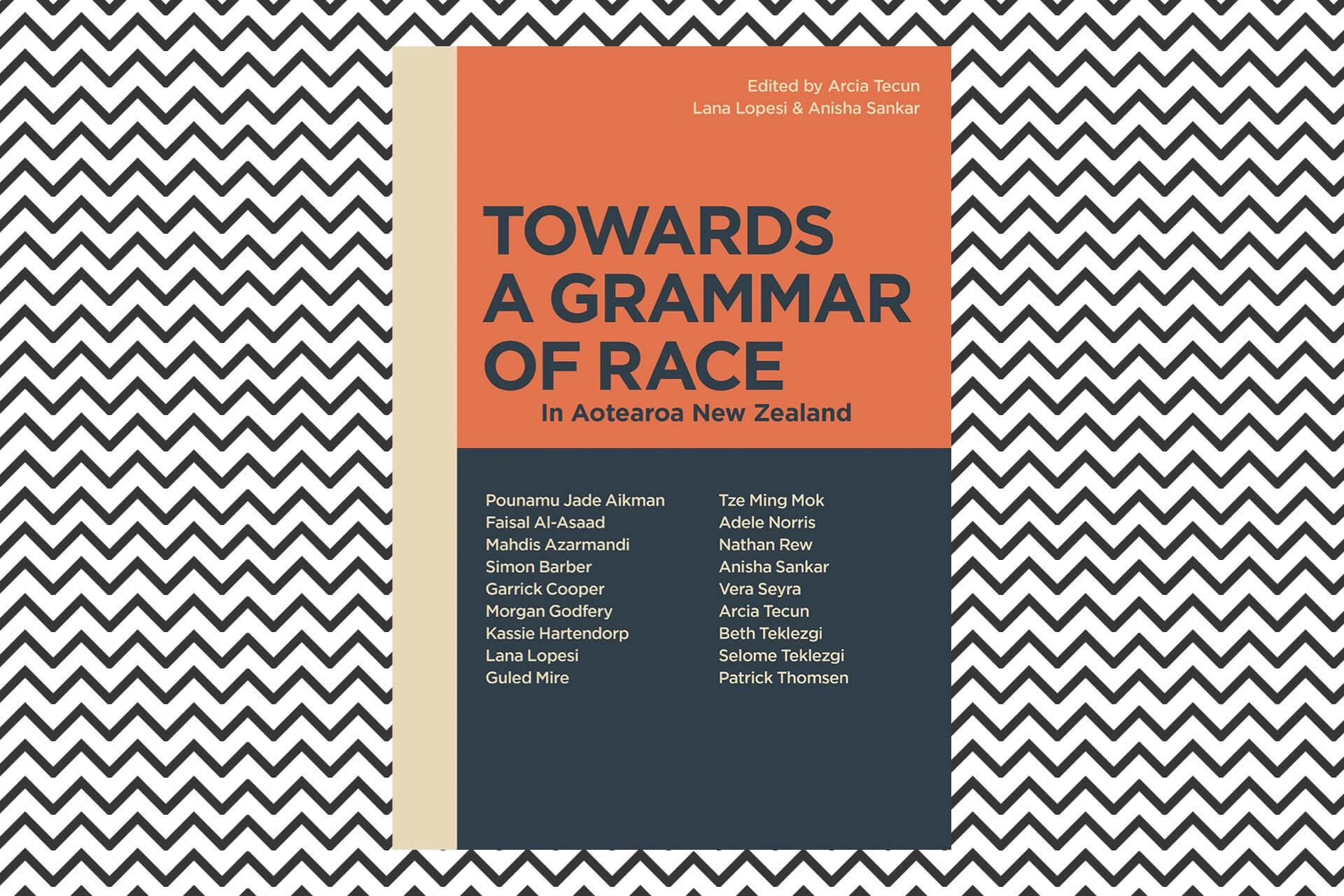Apr 23, 2023 Books
Last month, I was sitting next to a Pākehā man at a dinner who was complaining about Three Waters. Like many other Pākehā opposing the reforms, he wouldn’t listen as I tried to explain why they’re so urgently needed. Instead, he claimed, without any evidence, that co-governance with iwi is “bad for New Zealanders”.
About a week later, I was having a heated conversation with a friend, a fellow Samoan man, about a Samoan rugby league player who was facing some backlash on social media for using the n-word in an Instagram post. Despite my attempts to explain why the post was racist, my friend said the backlash was “stupid” and that people like me were “haters trying to bring down a Brown man who was representing his country”.
Having these awkward, if not completely messed up, conversations recently has made me grateful for the arrival of Towards a Grammar of Race in Aotearoa New Zealand. The book, edited by Arcia Tecun, former Metro arts editor Lana Lopesi and Anisha Sankar, is a collection of chapters by 18 authors offering various perspectives on race in this country. Together these authors help the country work towards a “grammar of race” — defined by the editors as “the building blocks of a shared language we can use to discuss the complex matter of race in Aotearoa New Zealand, its connections to New Zealand as a settler colonial and capitalist nation, and our own positions within it”. With these building blocks, the book offers an intervention into a big but often unacknowledged problem facing the country — that we often lack the grammar and vocabulary to have meaningful conversations about race that could ultimately help us move towards a more equitable and anti-racist future.
To be clear, Towards a Grammar of Race isn’t a ‘how to’ or ‘for beginners’ guide for talking about race. It also isn’t an easy-to-read book for well-meaning white people who want to start their anti-racist journey, like international bestsellers White Fragility and How To Be an Antiracist. Instead, the book challenges readers to embrace the complicated pluralities of race in Aotearoa New Zealand and beyond, with the editors declaring from the outset: “Many of the writers hold different yet related ideas, and at times these may be in tension with one another… we do not assert a singular way of thinking, because we want to arrive at a point of openness.”
Some might see this openness as a shortcoming of the book and prefer a grammar of race that is more uniform and straightforward. However, in my opinion, it’s the book’s ambitious endeavour to capture (some of) the countless manifestations of race that makes it so compelling.
While I’m sure Tecun, Lopesi and Sankar could have just written a fantastic grammar of race on their own, when you read the contributions together, you realise what would have been lost if they had. That is, the understanding that if we want to have meaningful conversations about race, we must learn how to “hold the tensions of different experiences” and forgo the tempt- ing (but futile) search for a simple universal truth.
In terms of the chapters themselves, I could write a lot about each one and how essential it is to a grammar of race for the country — there (honestly) aren’t any standouts or weak links. As with a great album or a classic collection of poetry, I anticipate that readers will find some chapters deeply resonate with them at one point in time and other chapters they will come back to.
For me, especially after the terrible conversation I had about Three Waters, I’m incredibly appreciative of the book’s commitment to developing a grammar for discussing the Crown’s ongoing colonisation of Aotearoa New Zealand. This commitment is evident in several contributions, including but not limited to: Garrick Cooper’s excellent case for a more nuanced understanding of how “colonialism constantly produces new institutions of oppression” like “tribal bureaucracies” that can marginalise Māori who are disconnected from them; Pounamu Jade William Emery Aikman’s incisive analysis of how racist constructions of Māori have allowed for the “extraordinary” generation of economic capital by Pākehā and the settler colonial state; and Mahdis Azarmandi’s sharp examination of how “Pākehā-ness” cannot be removed from whiteness and white supremacy.
As a Samoan living in a moment when Pacific peoples are being called out for their anti-Black racism, I’m really thankful for the contributions that help develop a grammar for unpacking how anti-Blackness operates in Aotearoa New Zealand and beyond. These contributions include brilliant chapters by Morgan Godfery (Metro te ao Māori editor) and Tze Ming Mok. These, among other important things, help to explain how anti-Blackness shapes constructions of race in relation to Māori and Asian peoples respectively. Later, Nathan Rew’s groundbreaking critical history and analysis of Indonesia’s colonisation of West Papua issues a call to action to all in Oceania to “come together and lead in the fight against anti-Blackness across our ocean, to overcome these systems which kill our siblings and destroy our environments”. Following this, Adele Norris and Guled Mire powerfully explain how Brown people in Aotearoa New Zealand weaponise the n-word against Black youth as an expression of anti-Blackness. Finally, to close the book, activists Beth Teklezgi, Selome Teklezgi, Vera Seyra and Kassie Hartendorp reflect on their organisation of the 2020 Black Lives Matter protest in Te Whanganui-a-Tara (Wellington) and, in doing so, provide readers with an inspiring example of solidarity both in action and in conversation.
While the contributions are beautifully crafted, I appreciate that a criticism some might have of the book is that much of it is inaccessible. This is because many of the contributions draw on academic theories and concepts that can sometimes make them hard to understand. As an academic, I’m probably biased, but I think, on balance, the book’s strong embrace of academic theory is necessary at this somewhat early stage in the development of Aotearoa New Zealand’s grammar of race. This isn’t to say that there isn’t an urgent need to communicate these important ideas in ways that can be understood by as many people as possible, because there obviously is. But this is a major challenge that faces all anti-racist theorists, writers and advocates worldwide. The remarkable thing about Towards a Grammar of Race is that it brings us closer to overcoming this challenge. We have to start or come from somewhere, and this book makes it very clear that our collective goal of finding a grammar of race is only just beginning.
I also want to acknowledge that a few books before this one have brought together different perspectives on race and ethnicity. While those books have made essential contributions to discourses around race in this country, Towards a Grammar of Race feels different. It feels like a living movement bursting with hope — one that began with a group of three friends, grew into a collective of 18 authors and now has the potential to extend across Aotearoa New Zealand and beyond.
Towards a Grammar of Race
Editors: Arcia Tecun, Lana Lopesi and Anisha Sankar
BWB
$39.99
–






